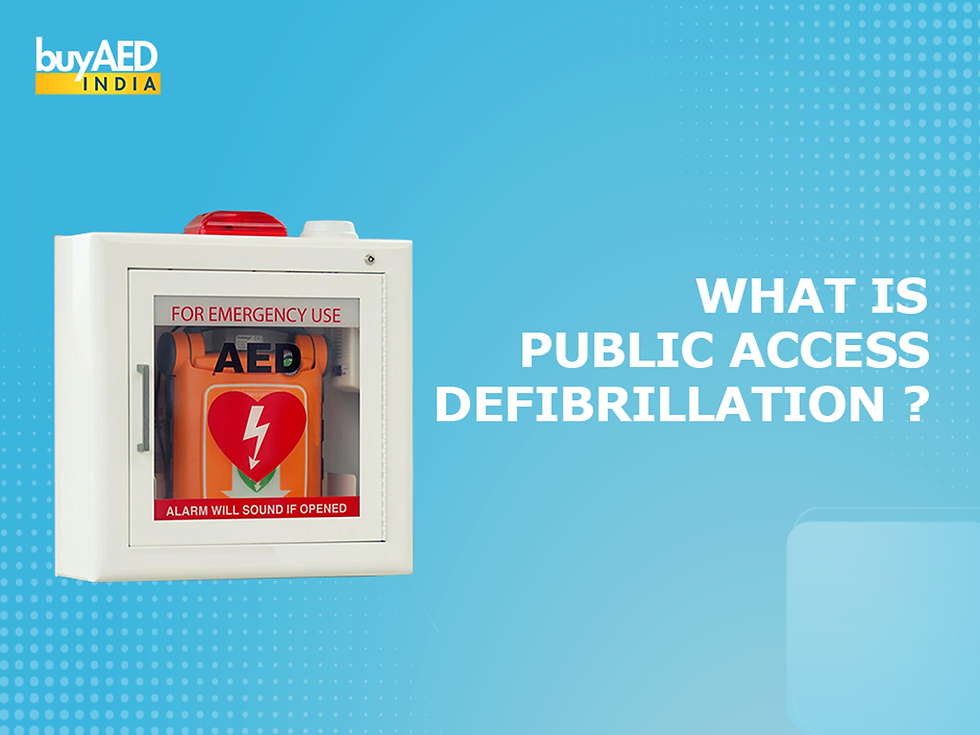Can you Defibrillate with a Pacemaker?
- Dr. Shruti Shah

- Jan 10
- 5 min read
Updated: Feb 5
Have you ever wondered whether it's safe to use a Defibrillator for people who have pacemakers?
It's a very common issue particularly in the event of an emergency cardiac situation.
The positive side is that it's feasible and is safe with some cautions.
This blog we'll break it all into pieces so that you can tackle the situation with confidence.
Before we get into defibrillation let's take an understanding about what the pacemaker is and how it operates.
What Is a Pacemaker?
Think of a pacemaker as a tiny, life-saving conductor for your heart.
It’s a small, battery-powered device implanted in the chest to help people with irregular heartbeats (arrhythmias).
The pacemaker ensures the heart beats steadily and effectively.
How Does a Pacemaker Work?
Pacemakers monitor your heart’s rhythm 24/7.
When it detects an irregularity, it sends electrical impulses to restore a normal rhythm.
Imagine it as a tiny guardian angel keeping your heart in sync every moment of the day.
Understanding Defibrillation
Defibrillation is another heart-saving superhero, but it works differently from a pacemaker.
Let’s explore!
What Is Defibrillation?
Defibrillation involves delivering a controlled electric shock to the heart to restore a normal rhythm.
It’s typically used during cardiac arrest when the heart stops beating effectively.
How Do Defibrillators Work?
Automated External Defibrillators (AEDs) are designed to analyze the heart’s rhythm.
If the device detects an irregularity that needs correction, it delivers a shock.
AEDs are intuitive and even guide users step-by-step, making them accessible for anyone to use during emergencies.
How to Use an AED on Someone with a Pacemaker?
To properly use an AED on someone with a pacemaker who has suffered SCA, you should call for help, perform CPR and then initiate lifesaving shocks once an AED has been located.
Step 1 - Recognize Cardiac Arrest and Dial 112:
Conduct an assessment to make sure it's safe for you to assist the victim.
Check for Responsiveness: If a victim does not respond and breathe normally, they could be experiencing cardiac arrest and need urgent help.
Step 2- Push and Perform CPR:
Perform CPR to initiate CPR, begin hard and fast chest compressions on the center of the chest area while asking others around to help you call 911 and retrieve an AED device if possible.
Step 3 - Shock: Once Your AED Arrives:
Here are the steps for using an AED on someone with a pacemaker:
Switch on the AED and follow its audio instructions.
Remove clothing Surrounding the patient's chest (including bra).
Locate and install a pacemaker: these implants should typically be located on the upper left side, below the collarbone. However, surgeons may opt to place it elsewhere if a preexisting condition prevents this. Regardless, visually inspect both locations.
Apply AED pads directly onto a person's bare chest skin. Make sure their chest is completely dry. Position the pads a minimum of three centimeters from any pacemakers located around the upper right side of their chest; companies have designed pacemakers specifically to withstand shocks from AEDs, so it is vital that these pads are placed far enough from them to minimize risk.
Allowing the AED to assess their heart rhythm.
Deliver a Shock (if necessary): the AED will detect if someone is experiencing cardiac arrest and deliver the appropriate defibrillation shock. Make sure no one touches them while using this procedure!
Conduct CPR and Re-analyze. AEDs are programmed with American Heart Association guidelines, which stipulate two minutes of CPR between AED heart rhythm analysis periods. Please follow your AED's instructions when using it.
Continue listening to the AED until EMS arrives and takes over rescue efforts.
Learn More: What is CPR? CPR for Heart Attack
Defibrillation and Pacemakers: Are They Compatible?
Now, let’s tackle the big question: can you safely use a defibrillator on someone with a pacemaker?
Can You Safely Use a Defibrillator on Someone with a Pacemaker?
Yes, you can! AEDs are designed to work independently of implanted devices like pacemakers.
As long as the defibrillator pads are positioned correctly, the shocks can be delivered without interfering with the pacemaker.
How Does Defibrillation Affect a Pacemaker?
Defibrillation might momentarily disrupt a pacemaker’s function, but modern pacemakers are resilient.
They usually reset themselves quickly and resume normal operation.
Precautions When Using a Defibrillator on a Pacemaker Patient
Saving a life is the priority, but a few precautions can make all the difference when defibrillating someone with a pacemaker.
Positioning the Pads
Ensure the AED pads are placed at least an inch away from the pacemaker site.
This avoids direct interference and ensures the electric shock travels efficiently through the heart.
Monitoring the Patient
After defibrillation, it’s crucial to check the patient’s vitals.
Watch for any irregularities and ensure the pacemaker continues to function as intended.
If there’s any concern, seek medical assistance promptly.
Myths About Defibrillation and Pacemakers
Let’s debunk some common myths that might be floating around.
Does Defibrillation Always Damage a Pacemaker?
Not at all! Modern pacemakers are built to withstand external shocks.
While minor disruptions can happen, permanent damage is extremely rare.
Are People with Pacemakers Exempt from CPR or AED Use?
No way! AEDs and CPR are just as essential for someone with a pacemaker as for anyone else. These interventions save lives and should always be used when needed.
Advancements in Technology
Technology keeps making things better, and both pacemakers and defibrillators have seen incredible advancements.
Modern Pacemakers: Resilience and Adaptability
Today’s pacemakers are designed to handle external shocks like a pro. They’re equipped with features that ensure they keep functioning even after defibrillation.
Defibrillators with Pacemaker-Safe Modes
Some AEDs now come with advanced settings to safely accommodate patients with pacemakers.
These devices are fine-tuned to deliver effective shocks without impacting implanted devices.
Why Did You Choose BuyAEDIndia for Defibrillator?
When it comes to buying defibrillators, BuyAEDIndia is a trusted choice for many.
They offer a wide range of high-quality AEDs from top global brands, ensuring you get reliable and effective life-saving devices.
Their prices are competitive, making it easy for individuals and organizations to find options that fit their budgets without compromising on quality.
The purchasing process is simple, thanks to their easy-to-navigate website and expert customer support.
If you're unsure about which device to choose, their team is always ready to guide you. Plus, with fast delivery and 24/7 assistance, you can count on them when it matters most.
In short, BuyAEDIndia provides everything you need great products, fair pricing, and excellent service to make life-saving technology accessible to all.
Conclusion
So, can you defibrillate someone with a pacemaker?
Absolutely! With proper pad placement and a bit of awareness, you can safely use a defibrillator on a pacemaker patient during a cardiac emergency.
Modern technology has your back, and the priority is always saving a life.
FAQs
1. Can an AED detect a pacemaker?
Yes, AEDs can detect a pacemaker but focus on analyzing the heart rhythm for abnormalities independently.
2. Is CPR safe for someone with a pacemaker?
Absolutely! CPR is not only safe but also crucial in cardiac emergencies for pacemaker patients.
3. Can defibrillation permanently damage a pacemaker?
It’s highly unlikely. Modern pacemakers are designed to handle external shocks without lasting damage.
4. How can you identify if someone has a pacemaker?
Look for a small bulge under the skin, typically on the chest, or ask the patient if they’re conscious.
5. What’s the safest way to use an AED on a pacemaker patient?
Ensure the pads are placed at least an inch away from the pacemaker to avoid interference.





Comments